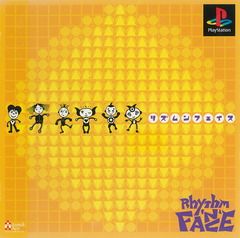Difference between revisions of "Rhythm 'n' Face"
Where am i (talk | contribs) |
(Add to PS1 Games category) |
||
| Line 117: | Line 117: | ||
{{Games}} | {{Games}} | ||
| + | [[Category: PS1 Games]] | ||
Revision as of 15:05, 20 December 2023
| Rhythm 'n' Face | |
|---|---|
| Original name | リズムンフェイス |
| Release date | 9 March 2000 |
| Format | Videogame |
| Lost? | No |
Rhythm 'n' Face (リズムンフェイス, Rizumunfeisu) is a rhythm video game developed by OutSide Directors Company and published by Asmik Ace Entertainment for the Playstation. The game was released in Japan on March 9th, 2000. A companion book with demonstrations on how to design with basic shapes, as well as designs contributed by various artists and journalists, was released alongside it.
Gameplay
The goal of every stage in Rhythm 'n' Face is to manipulate shapes (squares, triangles and circles) to create "faces" in sync with the stage music's beat. Pressing the Circle, Square, and Triangle buttons will select the respective shape and place it in the center of the grid, pressing the L1 and R1 buttons will increase and decrease the size of the shape, and pressing the D-Pad buttons will move the shape on the grid.
Each stage is comprised of a series of two short phases: a computer player will select a shape and manipulate it into a specific size and position, and the player must then copy the computer player's actions while keeping on-beat. If the player doesn't get a shape near the correct position and size before the end of their phase, they lose one life. If the player loses all four of their lives, they must restart the stage. If the player keeps correctly placing shapes, they will rack up a combo and gain a life back (assuming they have lost any). If the combo is high enough, the game will start the player's shapes in a random position on the grid to throw them off and further challenge them to keep their combo going.
At the end of a stage, the player is ranked in two categories: "Rhythm" and "Art", on a scale from 0 to 50. "Rhythm" measures how well the player did in keeping on-beat (as well as how many extra actions they did successfully), and "Art" is used to measure how accurate the player's face is to the intended face.
Every level's face also has an alternative form that can be created. These alternate faces are shown briefly on the loading screen when playing a level for the first time, and can also be found in the game's manual and website. Making these alternative faces will reward the player with additional Art points.
Completing all four routes will unlock the ability to toggle three additional settings in the options menu:
- Texture: Overlays a texture onto every shape.
- Fukuwarai: Makes the active shape as well as all previously placed shapes invisible until the end of the stage.
- Duet: Enables a turn-based multiplayer mode. Whenever one player fails to move a shape correctly, it will become the other player's turn.
If you get 350 total points on any route, that route's bonus stage will be unlocked. The bonus stages act as free-paint modes, allowing you to make faces without having to worry about rhythmic timing or copying the computer player's actions.
Tracklist
| Stage | Track | Character | Genre |
|---|---|---|---|
| 1 | Happy Peace Smile | Namihei Panda | Pops |
| 2 | Swan Song 2000 | Panda Stewart | Disco |
| 3 | Fat Tiger Blues | Torkee | R&B |
| Dr Boochang Lee | Klinton | Funk | |
| 4 | Something in Heaven | Hajime | Jazz |
| Dabster & Dubstar | Adidos | Reggae | |
| Rock the Rocket | Tomson | Rock | |
| Green Castle | Kwai Polnuki | Polka | |
| 5 | Wondering Bullfighter | Gaudi Barcelona | Flamenco |
| Quiet Rose | Beatty | Bossa Nova | |
| Apollo Comic | 808 | Techno | |
| Durian Moon | Acadi | Ethno | |
| Bonus | Water #036 | N/A | Modern |
| Steel #036 | N/A | Modern | |
| Universe #036 | N/A | Modern | |
| Voice #036 | N/A | Modern |
Trivia
- The name of Fukuwarai mode refers to a Japanese children's game similar to Pin the Tail on the Donkey, where blindfolded players attempt to pin body parts onto a blank face.
- A demo version appears on the coverdisc for the March 2000 issue of Famitsu Wave magazine, containing the first stage. The build appears to be from late 1999 and has some graphical differences, mostly in the menus.
External Links
See also
- ●▲■, a game with a very similar control scheme.
| ShowGames by Outside Directors Company |
|---|
